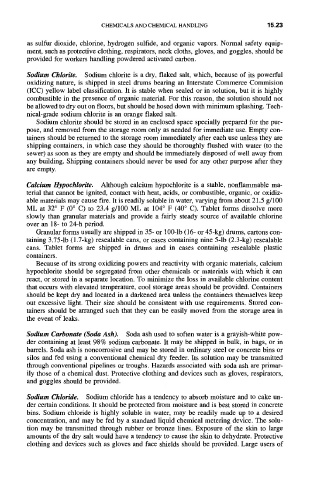Page 516 -
P. 516
CHEMICALS AND CHEMICAL HANDLING 15.23
as sulfur dioxide, chlorine, hydrogen sulfide, and organic vapors. Normal safety equip-
ment, such as protective clothing, respirators, neck cloths, gloves, and goggles, should be
provided for workers handling powdered activated carbon.
Sodium Chlorite. Sodium chlorite is a dry, flaked salt, which, because of its powerful
oxidizing nature, is shipped in steel drums bearing an Interstate Commerce Commision
(ICC) yellow label classification. It is stable when sealed or in solution, but it is highly
combustible in the presence of organic material. For this reason, the solution should not
be allowed to dry out on floors, but should be hosed down with minimum splashing. Tech-
nical-grade sodium chlorite is an orange flaked salt.
Sodium chlorite should be stored in an enclosed space specially prepared for the pur-
pose, and removed from the storage room only as needed for immediate use. Empty con-
tainers should be returned to the storage room immediately after each use unless they are
shipping containers, in which case they should be thoroughly flushed with water (to the
sewer) as soon as they are empty and should be immediately disposed of well away from
any building. Shipping containers should never be used for any other purpose after they
are empty.
Calcium Hypochlorite. Although calcium hypochlorite is a stable, nonflammable ma-
terial that cannot be ignited, contact with heat, acids, or combustible, organic, or oxidiz-
able materials may cause fire. It is readily soluble in water, varying from about 21.5 g/100
ML at 32 ° F (0 ° C) to 23.4 g/100 ML at 104 ° F (40 ° C). Tablet forms dissolve more
slowly than granular materials and provide a fairly steady source of available chlorine
over an 18- to 24-h period.
Granular forms usually are shipped in 35- or 100-1b (16- or 45-kg) drums, cartons con-
taining 3.75-1b (1.7-kg) resealable cans, or cases containing nine 5-1b (2.3-kg) resealable
cans. Tablet forms are shipped in drums and in cases containing resealable plastic
containers.
Because of its strong oxidizing powers and reactivity with organic materials, calcium
hypochlorite should be segregated from other chemicals or materials with which it can
react, or stored in a separate location. To minimize the loss in available chlorine content
that occurs with elevated temperature, cool storage areas should be provided. Containers
should be kept dry and located in a darkened area unless the containers themselves keep
out excessive light. Their size should be consistent with use requirements. Stored con-
tainers should be arranged such that they can be easily moved from the storage area in
the event of leaks.
Sodium Carbonate (Soda Ash). Soda ash used to soften water is a grayish-white pow-
der containing at least 98% sodium carbonate. It may be shipped in bulk, in bags, or in
barrels. Soda ash is noncorrosive and may be stored in ordinary steel or concrete bins or
silos and fed using a conventional chemical dry feeder. Its solution may be transmitted
through conventional pipelines or troughs. Hazards associated with soda ash are primar-
ily those of a chemical dust. Protective clothing and devices such as gloves, respirators,
and goggles should be provided.
Sodium Chloride. Sodium chloride has a tendency to absorb moisture and to cake un-
der certain conditions. It should be protected from moisture and is best stored in concrete
bins. Sodium chloride is highly soluble in water, may be readily made up to a desired
concentration, and may be fed by a standard liquid chemical metering device. The solu-
tion may be transmitted through rubber or bronze lines. Exposure of the skin to large
amounts of the dry salt would have a tendency to cause the skin to dehydrate. Protective
clothing and devices such as gloves and face shields should be provided. Large users of

